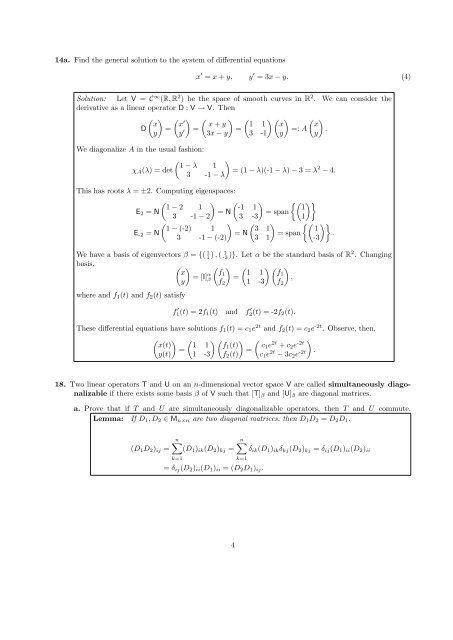Homework 7 Solutions
Homework 7 Solutions
Homework 7 Solutions
You also want an ePaper? Increase the reach of your titles
YUMPU automatically turns print PDFs into web optimized ePapers that Google loves.
14a. Find the general solution to the system of differential equations<br />
x ′ = x + y, y ′ = 3x − y. (4)<br />
Solution: Let V = C∞ (R, R2 ) be the space of smooth curves in R2 . We can consider the<br />
derivative as a linear operator D : V → V. Then<br />
<br />
′ x x<br />
D =<br />
y y ′<br />
<br />
x + y 1<br />
= =<br />
3x − y 3<br />
<br />
1 x x<br />
=: A .<br />
-1 y y<br />
We diagonalize A in the usual fashion:<br />
<br />
1 − λ 1<br />
χA(λ) = det<br />
= (1 − λ)(-1 − λ) − 3 = λ<br />
3 -1 − λ<br />
2 − 4.<br />
This has roots λ = ±2. Computing eigenspaces:<br />
<br />
1 − 2 1 -1 1<br />
1<br />
E2 = N<br />
= N = span<br />
3 -1 − 2 3 -3<br />
1<br />
<br />
1 − (-2) 1<br />
3 1<br />
1<br />
E-2 = N<br />
= N = span .<br />
3 -1 − (-2) 3 1<br />
-3<br />
We have a basis of eigenvectors β = {( 1 1 ) , ( 1 -3 )}. Let α be the standard basis of R2 . Changing<br />
basis, <br />
x<br />
= [I]<br />
y<br />
α β<br />
where and f1(t) and f2(t) satisfy<br />
f1<br />
f2<br />
<br />
1 1 f1<br />
=<br />
,<br />
1 -3<br />
f2<br />
f ′ 1(t) = 2f1(t) and f ′ 2(t) = -2f2(t).<br />
These differential equations have solutions f1(t) = c1e 2t and f2(t) = c2e -2t . Observe, then,<br />
<br />
x(t)<br />
y(t)<br />
=<br />
<br />
1<br />
<br />
1 f1(t)<br />
1 -3 f2(t)<br />
<br />
c1e<br />
=<br />
2t + c2e-2t <br />
.<br />
c1e 2t − 3c2e -2t<br />
18. Two linear operators T and U on an n-dimensional vector space V are called simultaneously diagonalizable<br />
if there exists some basis β of V such that [T]β and [U]β are diagonal matrices.<br />
a. Prove that if T and U are simultaneously diagonalizable operators, then T and U commute.<br />
Lemma: If D1, D2 ∈ Mn×n are two diagonal matrices, then D1D2 = D2D1.<br />
(D1D2)ij =<br />
n<br />
(D1)ik(D2)kj =<br />
n<br />
k=1<br />
k=1<br />
= δij(D2)ii(D1)ii = (D2D1)ij.<br />
4<br />
δik(D1)ikδkj(D2)kj = δij(D1)ii(D2)ii
















